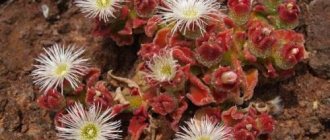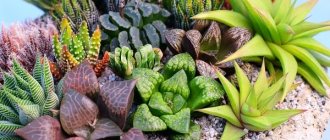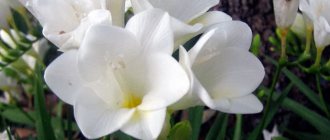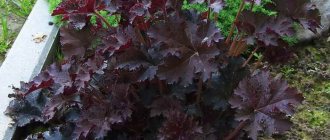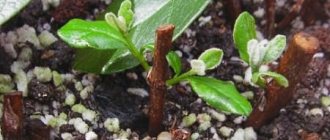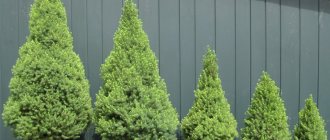On the shelves of flower shops and garden centers you can often see elegant flowers strewn with bright and glossy berries and fruits. These cranberry-like berries serve as ornamental garnish for a tropical plant called wintergreen. Even novice gardeners can grow this beauty. It pleases the eye all year round when grown on windowsills at home, and also takes root well in open ground in flower beds.
Description
Wintergreen is a genus of low evergreen shrubs of the Heather family. It received its name in honor of the French botanist Jean-Francois Gaultier, who described it in Canada. Various species of these shrubs are found wild on all continents except Antarctica. In culture, it is most often used in gardens and rock gardens to create a green carpet or border. For its frost resistance, Wintergreen was even nicknamed winter-loving. But it looks no less impressive in pots when grown indoors, on open terraces or balconies. It has compact branches, small glossy leathery leaves with solid edges. Against the background of dense dark green foliage, white flowers with a pinkish tint, reminiscent of lilies of the valley, which appear in early summer, look advantageous. They are solitary or collected in small inflorescences, drooping, with thin petals, and exude a delicate aroma. No less decorative are the contrasting white, dark blue or bright red berries that set in August after the petals fall off. They look like cranberries, reach 1 cm in diameter, and are inedible. The berries can stay on the bush for several months, shrinking a little over time. The shrub grows slowly, but under good conditions it can live up to 50 years.
Reproduction and planting
To create a whole garden of such plants on the windowsill, it is enough to purchase one copy and propagate it at home. Wintergreen reproduces in the same way as other indoor flowers:
- cuttings (cuttings are harvested in June);
- dividing the rhizome (the procedure is carried out in the spring);
- seeds (young plants are transplanted into new containers only 3 months after the appearance of the first shoots);
- layering (strong, young shoots are lowered to the ground, dug in and fixed in this position).
Propagation of the American pear is not difficult even for novice gardeners. Young plants germinate and develop well, but do not tolerate transplantation into separate pots.
Secrets of success
Wintergreen is a very unpretentious and hardy plant that is extremely rarely affected by pests or diseases. It is not demanding in terms of lighting conditions, it can grow both in strong shade in the back of the room and in bright light, you just need to protect it from direct sunlight in the hot season. The optimal temperature for Wintergreen is cool, about +12°C. To decorate the interior during the New Year holidays, you can bring a green bush with bright berries into the room, but most of the time it is better for it to spend the winter on the balcony.
The room in which the plant is located must be well ventilated. Water twice a month generously, removing excess water from the pan. Use cool, always soft water, since the roots cannot tolerate lime. In summer, the leaves can be sprayed in the evening, trying to prevent water from getting on the flowers. From spring to autumn, special fertilizers for heathers are applied with watering. Dry branches are trimmed regularly.
general information
Wintergreen procumbens, or recumbent (gaultheria procumbens) is a ground cover representative of the Ericaceae family, native to North America. Today it is very popular among gardeners all over the world, who grow it as a houseplant or garden crop.
In mixed forests, the flower covers the soil with its smooth gray-brown stems, located between tall bushes and trees. Its shoots rise above the ground by only 10-15 centimeters.
This creeping shrub is covered with ovoid leaves 1.5–4 centimeters long. Their dark green leaves have a glossy surface, jagged edges and a pointed tip. Low temperatures cause the foliage to change color, causing it to take on an unusual purple color.
During the flowering period, wintergreen is transformed, because male and female flowers of a light pink hue bloom on it. The flowers are bell-shaped and consist of five petals and a corolla. They are very reminiscent of the goblet flowers of wild wintergreens, which is why wintergreen received another name - American pear. Flowers grow on shoots one at a time or form small inflorescences.
Wintergreen is a melliferous plant, so it is readily pollinated by bees. The flowering period begins in July and lasts until the first month of autumn. In September, red berries with a diameter of 5-15 millimeters appear in place of the flowers, which remain on the bush until next spring.
The population of North America calls the plant Eastern Teaberry, which translated into Russian sounds like tea berry. This name did not appear by chance, because indigenous peoples have been brewing American pear leaves for many centuries to make medicinal tea. This drink was used to treat migraines, rheumatoid pain and redness of the throat, and chewed the leaves to ease breathing after a hard day of work.
Popular varieties
Breeders have developed many varietal forms of wintergreen. Among them, it is worth highlighting those varieties that are popular among gardeners:
- Dart's Red Giant - distinguished by very large and bright berries. In flower shops it is most often found under the name “Large-fruited”, without indicating the varietal.
- Shallon is the tallest variety, capable of stretching up to 50 centimeters in height. It blooms with white or pink water lily flowers, which are collected in inflorescences on the tops of the shoots. During ripening, the berries change from purple to black, unlike other types and varieties, and have a rather pleasant taste with musky, blueberry and mint notes.
- Big Berry is a typical representative of the recumbent wintergreen. It grows up to 20 centimeters in height, has dark leathery leaves and white fruits, which become bright red as they grow.
- Ginura procumbens is actively gaining popularity; the plant has medicinal properties that are highly valued by traditional healers. The flower is even called “Leaves of the Gods” and “Cure for 100 Diseases”; representatives of the international scientific community are studying its active chemical composition.
It is worth familiarizing yourself with the latter variety in more detail. This unique evergreen bush has the following properties:
- has a beneficial effect on reproductive functions;
- reduces blood sugar;
- inhibits the development and growth of cancer cells;
- normalizes metabolic processes;
- can be used as an antioxidant;
- normalizes cholesterol levels.
Ginura procumbens has large leaves up to 3.5 cm wide and up to 8 cm long. Because of their taste and beneficial properties, the plant is called “longevity spinach.”
Beneficial features
In the 18th century, during the American Revolution, wintergreen foliage was soaked in warm water, then dried and used to prepare infusions. There is a hypothesis that it was this drink that, before the spread of Chinese leaf teas, was the first to be called tea, that is, tea. Until now, Americans often call the plant mountain tea, since its growing zone rises into the mountains.
In the 19th century, after a chemical analysis of the flower, a substance was discovered in its composition that has an anti-inflammatory effect and eliminates swelling of muscles and joints. It is called methyl salicylate, or oil of wintergreen, and is an organic acid dissolved in alcohol. A specific alcoholic smell can be felt if the foliage of the flower is crushed or rubbed. Only the following plants can synthesize such a substance:
- spirea;
- black birch;
- wintergreen;
- Wintergreen procumbens.
Young leaves contain less essential oils than mature leaves. It is worth noting that in production they are often used to flavor toothpastes. The leaves are collected throughout the summer season, after which they are soaked in water for a day and steam distilled to extract the essential oil. This product contains up to 98% methyl salicylate, so it is actively used in medicine for sprains, myalgia, rheumatism, neuralgia, as well as to eliminate cellulite and inflammation of the skin.
Wintergreen oil has even been used in the food industry. It is used to flavor various drinks, confectionery and sweets. According to one version, it was wintergreen that inspired people to create chewing gum.
As for the fruits of the plant, conflicting information can be found about them from different sources. Some reference books say that the berries are not poisonous, but are not suitable for human consumption. While American publications write about the edibility of fruits, experts describe their taste differently.
In the wild, many animals and birds use them for winter food, for example, partridges, mice, foxes, squirrels, bears and chipmunks. In America, such berries are used to make jams, jams and baking fillings, and also decorate pies with them. However, such a fruit cannot be called tasty; it is too mealy and not at all juicy.
Description
The vary species from low, ground-hugging shrubs less than 10 cm (3.9 in) tall, up to 2.5 m (8 ft 2 in) tall, or, in the case of G. fragrantissima
from the Himalaya, even a small tree up to 5–6 m (16–20 ft) tall. The leaves are evergreen, alternate (opposite in G. oppositifolia
from New Zealand), simple, and vary between species from 3 to 10 cm (1.2 to 3.9 in) long; the margins are finely serrated or bristly in most species, but entire in some. The flowers are solitary or in racemes, bell-shaped, with a five-lobed (rarely four-lobed) corolla; flower color ranges from white to pink to red. The fruit is a fleshy berry in many species, a dry capsule in some, with numerous small seeds.
Features of cultivation
Succulents: description, types, cultivation, planting, propagation and care at home, useful properties (70+ photos & videos) + reviews
Now let’s figure out how to plant this shrub correctly.
Choosing a location, lighting and soil
The plant does not tolerate dense shade. If the soil is moist enough, it is better to choose places that are lit but sheltered from the wind. The most suitable area for this would be an area with partial shade, for example, near deciduous and coniferous trees or shrubs, which, in addition, will protect the bush from strong winds.
It is usually grown on peaty, acidic soils with a pH of no more than 5, well-drained and loose. If you are working on heavy soil (clayey, loamy, etc.), remove the top layer by 25-30 cm, lay gravel and sand drainage underneath, add peat (three parts), half-rotted pine bedding (two), sand (one ).
Planting process
Wintergreen is planted in early spring. In dense soils, seedlings are planted at a distance of 22-26 cm from each other, in loose soils - at 38-40. The root collar should be level with the ground or slightly lower (about 1.5 cm). The depth of the hole is 30-40 cm. Drainage is in a layer of 12-16 cm.
Water it abundantly, but infrequently (twice a month, 6 liters of water per bush is enough). When it’s dry and hot outside, water more often and also spray the leaves. All this should be done in the evenings, after sunset. For watering, use soft, preferably rainwater.
Next, we will learn how to care for the plant so that it grows and bears fruit.
Fertilizing, mulching
In spring, the shrubs are fed with fertilizers. One of the most optimal options is “Kemira Universal” (the product takes 100 g per m² of land). Another option is nitroammophoska (when digging up the ground, take 40 g of granules per 1 m² and distribute them evenly over the surface).
Or you can use any other fertilizer with a high nitrogen content. In mid-summer, it is recommended to switch to nitrogen-free fertilizers.
In autumn, young plants are covered with dry leaves, while adults are mulched with peat or wood chips (layer - 9-10 cm).
Cleaning and trimming
When loosening the soil, it is necessary to remove weeds that harm the development of the bush.
Weeding should be done only with your hands, and the soil should also be loosened carefully so as not to damage the roots, since they are located close to the surface.
Before spring growth begins, the shoots need to be trimmed a little so that the plant can fully develop. And dry branches should be disposed of as needed, cutting them off completely.
In harsh winters, without shelter, wintergreen can freeze or even freeze completely.
But under the snow it is able to overwinter perfectly (even at 35°C below zero). Therefore, in winter, snow is thrown over the bush.
If the winter is not snowy, it will certainly be covered with spruce branches. Young plantings are covered with dry leaves or peat.
Wintergreen is endowed with remarkable resistance to diseases and pests. The main thing is to plant it in acidic soil and avoid waterlogging. Then serious difficulties will not arise.
Otherwise, it will very quickly die from rot or inconsistency of the soil pH. This is her main weakness.
Transplanting into separate containers
When preparing the soil, you should take into account the preferences of this northern flower. The wintergreen root system is a mycorrhiza, that is, a fungal root, and therefore cannot grow on calcareous soils. The plant prefers loose and acidic soils with good drainage.
Usually, to grow such bushes, red peat is used or a mixture is prepared from coarse river sand, humus and rotted pine needles, after which the substrate is spilled with an acidic solution of oxalic or citric acid. To prepare it, one teaspoon of the product is dissolved in 3 liters of clean water. You can also use acetic acid - 2.5 milliliters per 5 liters of water.
When buying a pot, you should pay attention to large specimens. For such a flower, it is better to purchase a container for growth, since it does not respond well to transplants. Therefore, fresh soil is periodically added to the pot, and there should be free space for it. In summer, it is better to place such bushes on balconies, terraces or in the open air in personal plots, so it is advisable to choose strong and convenient containers.
Planting begins by pouring drainage material into the bottom of the pot. It will not allow excess moisture to accumulate at the root system of the plant. For these purposes, you can use small pebbles, expanded clay, crushed stone, broken brick or clay shards.
If you purchase wintergreen of a suitable variety, and also provide it with comfortable conditions and good care, then the flower will delight all guests and household members all year round: in the summer - with delicate flowering and decorative foliage, in the winter - with fragrant and bright berries and fruits.
